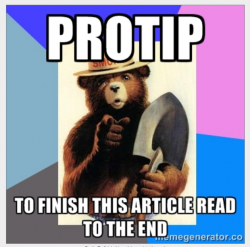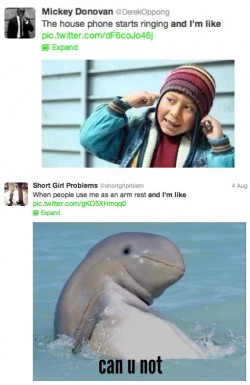According to Know Your Meme—a website devoted to cataloguing viral media’s indefatigable march across cyberspace—image macros (or captioned images) have been around for more than a century. It all started when an American photographer with a penchant for taking photos of animals dressed up like humans started slapping captions on his images.
 Of course, political cartoons had been upending Tammany Hall longer still, and labeled medical diagrams have been with us since the 15th century. But it took the Internet for captioned images to really take off. Today, anyone can add words to images in about 20 seconds using an online meme generator—no carving up blocks of wood or squeezing pigs into prom dresses required.
Of course, political cartoons had been upending Tammany Hall longer still, and labeled medical diagrams have been with us since the 15th century. But it took the Internet for captioned images to really take off. Today, anyone can add words to images in about 20 seconds using an online meme generator—no carving up blocks of wood or squeezing pigs into prom dresses required.
A few weeks ago, I pondered how a language composed wholly of images might work. But a more immediate question is how the widespread, spontaneous pairings of words and images function now.
The image macro is undeniably a playful medium, chock-full of cats and movie heroes and 1980s song lyrics. Typically, a series of image macros is built around either a common catchphrase (in which case the “game” involves scouring the Internet for appropriate images) or a common image (where the goal is to invent a suitable caption).
As with most games, there are rules. Some image macros—those built around the sarcastic catchphrase Cool Story, Bro come immediately to mind—should only be posted in specific contexts, such as in response to a previous contribution that was overly long and personal.
Captions, on the other hand, tend to be generated according to templates that dictate how words are spelled (the vs. teh vs. th), how they are pronounced (Oh my God vs. O.M.G. vs. ermahgerd), and how they are strung together. Consider, for instance, one image macro series built around the self-portrait of 18th-century painter Joseph Ducreux. Here, captions are composed of modern-day rap lyrics translated into faux-formal, old-timey English (Gentlemen, I inquire: Who hath released the hounds?).
But as with anything involving language, rules are never set in stone. And given the one-upmanship these games encourage, rules can change fast. Amanda Brennan, a meme librarian with Know Your Meme, researches memes as they emerge and mutate. In an email, she described one of the most interesting ones she’s encountered: an animated GIF of a dancing alien captioned When U Mom Com Hom And Make Hte Spagheti. As the meme spread, explains Brennan, others extended the dancing and misspellings to new creatures and new foods, eventually subverting it entirely. One could be forgiven for not keeping up.
So why should anyone care about a dancing aliens or rapping portraitists? They shouldn’t. Not yet. But like it or not, memes are playing an increasingly prominent role in public discourse. It’s now not uncommon to see them posted to comment sections and Facebook walls as genuine—if somewhat irreverent—contributions to a discussion. (Heck, the alien meme ended up on the official Tumblr page for the restaurant chain Denny’s.) Memes are also entering private conversations. “People are making funny memes and sharing them with just one or two people who are in the joke,” my brother tells me.
Moreover, many features of the language used in image macros and other memes are creeping offline. The Internet slang phrase “nom nom nom” can now be heard around the technophobe’s dinner table; what will be next to make the jump? Perhaps the use of –fag as a suffix? Brennan explains that the suffix was coined on the image-posting board 4chan in 2007 as an equal-opportunity descriptor: there were newfags who were new to the forum (and thus looked down upon), but also oldfags and musicfags and artfags. “Despite the homophobia and hate associated with the suffix, it’s been adopted and used as an identifier within some communities,” she tells me.
 The increasing ease with which we can combine language and pictures will only lead to further innovations. The influential language blogger Stan Carey recently spotted one such innovation popping up all over Twitter: a syntactic construction with images and image macros embedded inside it.
The increasing ease with which we can combine language and pictures will only lead to further innovations. The influential language blogger Stan Carey recently spotted one such innovation popping up all over Twitter: a syntactic construction with images and image macros embedded inside it.
The construction is a riff on the quotative like, where like serves to introduce a performance, verbal or otherwise. “Offline we might say I’m like and make a caricatured facial expression; online, we use images instead to communicate those stage reactions,” says Carey.
Image macros can be playful, trifling, even dumb, yes, but as James Joyce knew, linguistic innovation occurs in those realms too.

